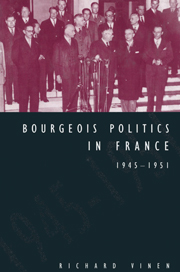Book contents
- Frontmatter
- Contents
- Preface
- List of abbreviations and French political groups
- 1 Introduction
- 2 A historiographic overview
- 3 International comparisons
- 4 Notables
- 5 Bourgeois parties and the female electorate
- 6 Organized business and politics
- 7 Administration
- 8 Opposition nationale
- 9 The Parti Républicain de la Liberté
- 10 Machine à ramasser les Pétainistes? The Mouvement Républicain Populaire and the conservative electorate
- 11 The Rassemblement des Gauches Républicaines
- 12 The Rassemblement du Peuple Français
- 13 Independents and Peasants
- 14 The Groupement de Défense des Contribuables
- 15 Conclusion
- Appendix. The electoral law of 1951 and apparentements
- Bibliography
- Index
5 - Bourgeois parties and the female electorate
Published online by Cambridge University Press: 06 July 2010
- Frontmatter
- Contents
- Preface
- List of abbreviations and French political groups
- 1 Introduction
- 2 A historiographic overview
- 3 International comparisons
- 4 Notables
- 5 Bourgeois parties and the female electorate
- 6 Organized business and politics
- 7 Administration
- 8 Opposition nationale
- 9 The Parti Républicain de la Liberté
- 10 Machine à ramasser les Pétainistes? The Mouvement Républicain Populaire and the conservative electorate
- 11 The Rassemblement des Gauches Républicaines
- 12 The Rassemblement du Peuple Français
- 13 Independents and Peasants
- 14 The Groupement de Défense des Contribuables
- 15 Conclusion
- Appendix. The electoral law of 1951 and apparentements
- Bibliography
- Index
Summary
One of the most important, and frequently ignored, facts of political life in the Fourth Republic was that well over half the electorate voted for the first time in 1945: French women had been granted the vote by an ordinance of the provisional government in 1943. Furthermore, the success of conservatism in post-war France cannot be understood without reference to women's suffrage. The three major conservative parties had predominantly female electorates. Women provided around 53 per cent of the support for the Rassemblement du Peuple Français (RPF) and Centre National des Indépendants et Paysans (CNIP), and they made up between 58 and 62 per cent of the Mouvement Républicain Populaire (MRP) electorate. Without female suffrage, the Communists and Socialists would have secured an absolute majority of seats in parliament at the November 1946 election.
The reasons why women voted for conservative parties in the Fourth Republic have received very little attention. At the time, many political scientists regarded gender as a trivial issue and suggested that women merely voted as their husbands directed. Maurice Duverger had trouble persuading his colleagues to take his 1955 survey of women's voting habits seriously. In recent years, historical studies of the role of women have become fashionable, but this has not led to any renewal of interest in the female electorate of the Fourth Republic.
- Type
- Chapter
- Information
- Bourgeois Politics in France, 1945–1951 , pp. 46 - 55Publisher: Cambridge University PressPrint publication year: 1995

